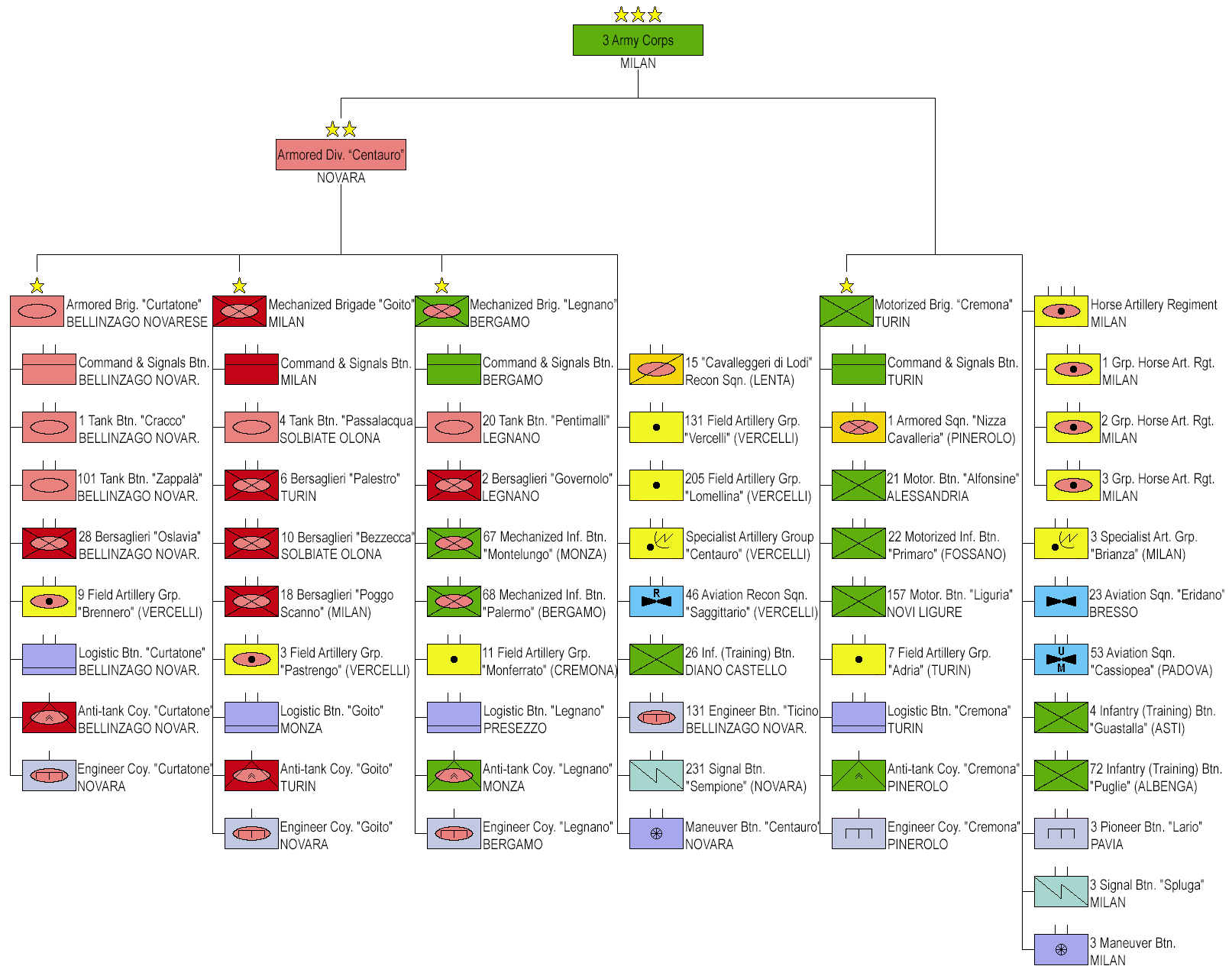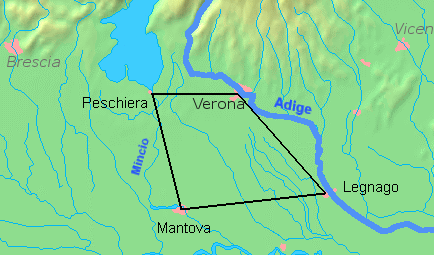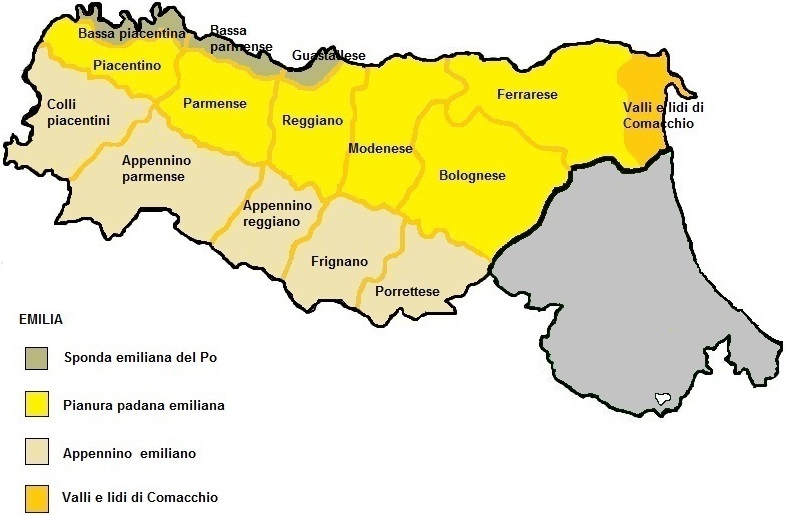|
III Army Corps (Italy)
The III Army Corps was one of three corps the Italian Army fielded during the Cold War. Based in the regions of Lombardy and Piedmont the corps was the army's operational reserve, while the 4th Alpine Army Corps and the 5th Army Corps, both based in the North East of Italy, were the army's front-line units. After the end of the Cold War the corps was reduced in size and on 1 December 2000 it ceded its last brigades to the 1st Defence Forces Command (COMFOD 1°). The personnel of the 3rd Army Corps was used to raise the NATO Rapid Deployable Italian Corps in January 2001. History Origins The history of the 3rd Army Corps begins after the second Italian war of independence. Following the Italian-French victory over the Austrian Empire, the Kingdom of Sardinia annexed the Papal Legations in present-day Emilia Romagna. Thus on 1 April 1860 the 3rd Higher Military Command was activated as a territorial command in Parma and tasked to defend the newly acquired territory between the ... [...More Info...] [...Related Items...] OR: [Wikipedia] [Google] [Baidu] |
Corps
Corps (; plural ''corps'' ; from French , from the Latin "body") is a term used for several different kinds of organization. A military innovation by Napoleon I, the formation was formally introduced March 1, 1800, when Napoleon ordered General Jean Victor Marie Moreau to divide his command into four corps. The size of a corps varies greatly, but two to five divisions and anywhere from 40,000 to 80,000 are the numbers stated by the US Department of Defense. Within military terminology a corps may be: *an military organization, operational formation, sometimes known as a field corps, which consists of two or more division (military), divisions, such as the I Corps (Grande Armée), , later known as ("First Corps") of Napoleon I's ); *an administrative corps (or Muster (military), mustering) – that is a #Administrative corps, specialized branch of a military service (such as an artillery corps, an armoured corps, a signal corps, a medical corps, a marine corps, or a corps of ... [...More Info...] [...Related Items...] OR: [Wikipedia] [Google] [Baidu] |
Kingdom Of Sardinia
The Kingdom of Sardinia, also referred to as the Kingdom of Sardinia and Corsica among other names, was a State (polity), country in Southern Europe from the late 13th until the mid-19th century, and from 1297 to 1768 for the Corsican part of this kingdom. The kingdom was a member of the Council of Aragon and initially consisted of the islands of Corsica and Sardinia, sovereignty over both of which was claimed by the papacy, which granted them as a fief, the (Kingdom of Sardinia and Corsica), to King James II of Aragon in 1297. Beginning in 1324, James and his successors Aragonese conquest of Sardinia, conquered the island of Sardinia and established ''de facto'' their ''de jure'' authority. In 1420, after the Sardinian–Aragonese war, the last competing claim to the island was bought out. After the union of the crowns of Aragon and Crown of Castile, Castile, Sardinia became a part of the burgeoning Spanish Empire. In 1720, the island and its kingdom were ceded by the House o ... [...More Info...] [...Related Items...] OR: [Wikipedia] [Google] [Baidu] |
Austria-Hungary
Austria-Hungary, also referred to as the Austro-Hungarian Empire, the Dual Monarchy or the Habsburg Monarchy, was a multi-national constitutional monarchy in Central Europe#Before World War I, Central Europe between 1867 and 1918. A military and diplomatic alliance, it consisted of two sovereign states with a single monarch who was titled both the Emperor of Austria and the King of Hungary. Austria-Hungary constituted the last phase in the constitutional evolution of the Habsburg monarchy: it was formed with the Austro-Hungarian Compromise of 1867 in the aftermath of the Austro-Prussian War, following wars of independence by Hungary in opposition to Habsburg rule. It was dissolved shortly after Dissolution of Austria-Hungary#Dissolution, Hungary terminated the union with Austria in 1918 at the end of World War 1. One of Europe's major powers, Austria-Hungary was geographically the second-largest country in Europe (after Russian Empire, Russia) and the third-most populous (afte ... [...More Info...] [...Related Items...] OR: [Wikipedia] [Google] [Baidu] |
Naples
Naples ( ; ; ) is the Regions of Italy, regional capital of Campania and the third-largest city of Italy, after Rome and Milan, with a population of 908,082 within the city's administrative limits as of 2025, while its Metropolitan City of Naples, province-level municipality is the third most populous Metropolitan cities of Italy, metropolitan city in Italy with a population of 2,958,410 residents, and the List of urban areas in the European Union, eighth most populous in the European Union. Naples metropolitan area, Its metropolitan area stretches beyond the boundaries of the city wall for approximately . Naples also plays a key role in international diplomacy, since it is home to NATO's Allied Joint Force Command Naples and the Parliamentary Assembly of the Mediterranean. Founded by Greeks in the 1st millennium BC, first millennium BC, Naples is one of the oldest continuously inhabited urban areas in the world. In the eighth century BC, a colony known as Parthenope () was e ... [...More Info...] [...Related Items...] OR: [Wikipedia] [Google] [Baidu] |
Battle Of Custoza (1866)
The Battle of Custoza took place on the 24 June 1866 during the Third Italian War of Independence in the Italian unification process. The Austrian Imperial army, joined by the Venetian Army, jointly commanded by Archduke Albrecht of Habsburg, defeated the Italian army, led by Alfonso Ferrero La Marmora and Enrico Cialdini. Background In June 1866, the German Kingdom of Prussia declared war on the Austrian Empire. The recently formed Kingdom of Italy decided to seize the opportunity and allied with Prussia with the intention of annexing Venetia and thus uniting the Italian Peninsula. The Italians rapidly built up a military force that was twice the size of their Austrian counterparts defending Venetia. Order of battle Austrian South Army (Field Marshal Archduke Albrecht) *''V Corps'' (General Gabriel Freiherr von Rodich) ::Moering, Piret Brigades *''VII Corps'' (General Joseph Freiherr von Maroicic) ::Scudier, Töply, Welsersheimb Brigades *''IX Corps'' (General Ern ... [...More Info...] [...Related Items...] OR: [Wikipedia] [Google] [Baidu] |
Quadrilatero
The ''Quadrilatero'' (, for greater specificity often called the "Quadrilateral fortresses") is the traditional name of a defensive system of the Austrian Empire in the Lombardy-Venetia region of Italy, which connected the fortresses of Peschiera, Mantua, Legnago and Verona between the Mincio, the Po, and the Adige Rivers. The name refers to the fact that on a map the fortresses appear to form the vertices of a quadrilateral. In the period between the end of the Napoleonic Wars and the Revolutions of 1848, they were the only fully modernized and armed fortresses within the Empire.Rothenburg, G. ''The Army of Francis Joseph''. West Lafayette: Purdue University Press, 1976. p 18. Starting from c. 1850, supplies and reinforcements were shipped to the positions through the new Venice-Milan railroad. The experience of the Second Italian Independence War of 1859, in which rifled guns had been used for the first time by the Italian Army, pushed the Austrians to build a second ... [...More Info...] [...Related Items...] OR: [Wikipedia] [Google] [Baidu] |
Mincio
The Mincio (; ; ; ; ) is a river in the Lombardy region of northern Italy. The river is the main outlet of Lake Garda. It is a part of the ''Sarca-Mincio'' river system which also includes the river Sarca and the Lake Garda. The river starts from the south-eastern tip of the lake at the town of Peschiera del Garda and then flows for about past Mantua and into the river Po. From Lake Garda until it reaches Pozzolo, it forms the boundary between Veneto and Lombardy regions. In the Etruscan period, the Mincio probably joined with the river Tartaro and flowed into the Adriatic Sea into the pit Filistina, in Roman Republic it was made to flow into the Po with three branches from Mantua by Quintus Curius Hostilius, subsequently reunited in a single embanked in 1198 on a project by Alberto Pitentino and regulated its course with several dams ( Ponte dei Mulini, Mantua) and the Governolo) dam to make it navigable, to prevent Mantua from being flooded by the flooding of the P ... [...More Info...] [...Related Items...] OR: [Wikipedia] [Google] [Baidu] |
Enrico Morozzo Della Rocca
Enrico Morozzo Della Rocca (Turin, 20 June 1807 – Luserna San Giovanni, 12 August 1897) was an Italian general, noble and politician, noted for his military service during the Risorgimento. Life Born from Carlo, Earl of Morozzo, Marquis of Brianzè and Lord of San Genuario, and Gabriella Asinari di Gresy, Enrico was the heir of one of the most prominent and noble Piedmontese families. He entered the Royal Military Academy of Turin in 1816, and graduated in 1824. His career was brilliant, if not particularly quick, and in 1848 he was promoted to colonel. During the First War of Italian Independence, he served as Chief of Staff of the Reserve Division, led by Crown Prince Vittorio Emanuele, beginning a close friendship with the future King; having distinguished himself at Goito, he was decorated with the Silver Medal of Military Valor. Promoted to Major General, Della Rocca commanded a brigade in the Battle of Novara. After the defeat, he was appointed Minister of War (from 2 ... [...More Info...] [...Related Items...] OR: [Wikipedia] [Google] [Baidu] |
Emilia (region Of Italy)
Emilia () is a historical region of northern Italy, which approximately corresponds to the western and the north-eastern portions of the modern region of Emilia-Romagna, with the area of Romagna forming the remainder of the modern region. Etymology Emilia takes its name from the Via Aemilia, a Roman road constructed by the consul Marcus Aemilius Lepidus in 187 BCE to connect Rimini with Piacenza. The name was transferred to the district (which formed the eighth Augustan region of Italy) as early as the time of Martial, in popular usage. In the 2nd and 3rd centuries Aemilia was frequently named as a district under imperial judges (), generally in combination with Flaminia or Liguria and Tuscia. The district of Ravenna was, as a rule, from the 3rd to the 5th century, not treated as part of Aemilia, the chief town of the latter being Placentia (Piacenza). In the 4th century Aemilia and Liguria were joined to form a consular province; after that Aemilia stood alone, Ravenna b ... [...More Info...] [...Related Items...] OR: [Wikipedia] [Google] [Baidu] |
Panaro (river)
The Panaro is an Italian river and the final right-hand tributary to the Po, discounting the Cavo Napoleonico canal. It runs right across Emilia-Romagna in a north-easterly direction: from its source close to the Apennine watershed, where Emilia-Romagna meets Tuscany, to its outlet where the Po marks the region's boundary with Veneto. Its Latin name was ''Scultenna''. It is long, with a drainage basin; alternating between aridity in summer and fullness in spring and autumn. Its principal source, the Rio delle Tagliole, rises at Foce a Giovo, Monte Rondinaio, some south-west of highest peak of the Tuscan- Emillian Apennines, Monte Cimone, elevation . From here it flows down the valley in a northeastern direction. At Pievepelago (in the Province of Modena) it changes name to Scoltenna, assuming in the territory of Pavullo nel Frignano finally that of Panaro. In this area it makes up the border between the communities of Montana del Frignano and Montana dell’appenni ... [...More Info...] [...Related Items...] OR: [Wikipedia] [Google] [Baidu] |
Trebbia
The Trebbia (stressed ''Trèbbia''; ) is a river predominantly of Liguria and Emilia Romagna in northern Italy. It is one of the four main right-bank tributaries of the river Po, the other three being the Tanaro, the Secchia and the Panaro. Along its eastern banks in 218 BC was fought one of the great battles of the Second Punic War. In the Battle of Trebbia, Hannibal defeated a Roman consular army. The drainage basin is divided among Emilia Romagna, , Liguria, , and Lombardy, . Its principal tributaries are the torrents Aveto and Perino (from the right) and the torrent Boreca (from the left). Geography The source of the river, the Trebbia river spring, is in the Ligurian Apennines on the south slopes of Monte Prelà, to the south of Monte Antola in the ''comune'' of Torriglia, Province of Genoa. Monte Prelà, high,The other reference has . is part of the Antola massif. The spring is not on the peak but is at roughly . Across a small ridge to the west, on which si ... [...More Info...] [...Related Items...] OR: [Wikipedia] [Google] [Baidu] |







